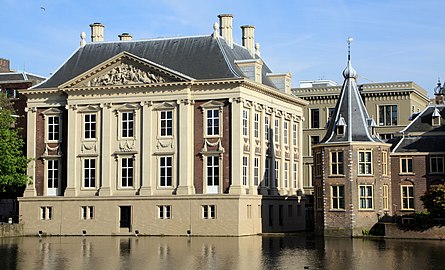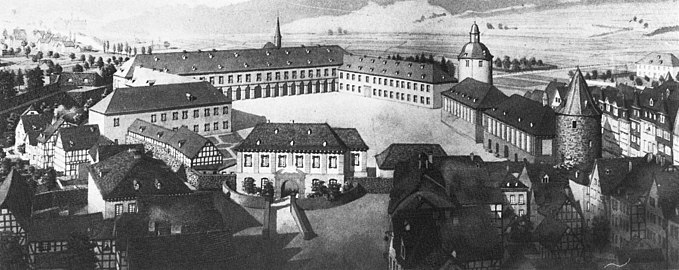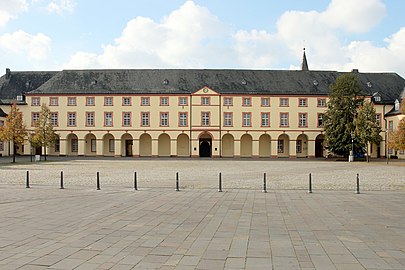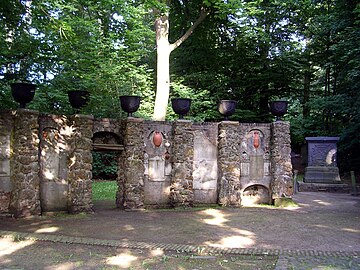Johann Moritz (Nassau-Siegen)

Johann Moritz Prince of Nassau-Siegen , Dutch Johan Maurits van Nassau-Siegen, called: "The Brazilian", (born June 17 or June 18, 1604 in Dillenburg , † December 20, 1679 in Berg und Tal in the district of Hau in the municipality of Bedburg-Hau) was a Dutch field marshal . Born as the son of Count Johann VII. Von Nassau-Dillenburg , he came from the extensive Nassau princely family , from which the House of Orange also emerged . In 1652 he was raised to the rank of imperial prince .
Life
Moritz entered the service of the Republic of the United Netherlands in 1621 and distinguished himself under the leadership of Prince Friedrich Heinrich of Orange in 1626 at the siege of Groenlo and in 1632 at Maastricht .
Appointed Governor General of the possessions of the Dutch West India Company in Brazil ( Dutch Brazil ) in 1636 , he conquered a large part of the country and managed it so admirably that it flourished . Its extensive natural history and ethnographic collection, which was brought together in Brazil, changed the image of the New World through its dissemination at the European royal courts. Impressive visual evidence of this expedition has been preserved by the painters Frans Post (1612–1680) and Albert Eckhout (1610–1665; Theatrum rerum naturalium Brasiliae ) as well as by the twelve-volume work Historia Naturalis Brasiliae sponsored by Moritz von Nassau .

In 1637 he sent an expedition with nine ships and around 800 soldiers to the African coast, which conquered the Portuguese fortress and most important trading post on the coast of Guinea , São Jorge da Mina , for the Dutch . In the spring of 1638 he penetrated the Brazilian coast south, but besieged Bahia in vain.
After the Portuguese and Spanish fleets were almost completely destroyed by the Dutch off Itamaracá (January 12-17, 1640), the war in Brazil began again and was fought with great cruelty. In order to employ the large number of adventurers under his banner, he went on an expedition to Chile (1643).
In Brazil, two places he founded were named after him, the Moritzschloss fortress at the mouth of the Rio São Francisco and the city of Mauritsstad (Moritzstadt, today Recife ).
Returned to Holland in 1644, he was appointed governor of Wesel and general of the cavalry. His friendship with the Brandenburg Elector Friedrich Wilhelm , whom he had met in 1635, was strengthened when he married Louise Henriette , the eldest daughter of the Dutch governor Friedrich Heinrich von Orange, in 1646 . In 1649 the elector appointed him governor in Kleve and Mark , and from 1658 also from Minden . As the Dutch commander of the fortresses on the right bank of the Rhine and as the Brandenburg governor, Johann Moritz had a double function that made him a guarantor of the stability of the western territories of Brandenburg.
His experience, his negotiating skills and the good contacts predestined him for high-ranking diplomatic missions in the service of Brandenburg. In 1652 Emperor Ferdinand III raised him . in the imperial princes. On this occasion, Johann Moritz gave "his" city Siegen the famous little crown on St. Nicholas' Church in 1658 . Also in 1652, at the request of the Great Elector, he was appointed Lord Master of the Order of St. John of the Brandenburg Ballei and previously hurriedly made a Knight of St. John by Order Senior Georg von Winterfeld . Johann Moritz also held this office with great success. He managed to develop economically and culturally the area devastated by the Thirty Years War . This also included the new construction of the Johanniter Castle in Sonnenburg (Neumark) .
In 1658 he worked as the Brandenburg envoy to the election of Emperor Leopold I in Frankfurt, concluded the defensive treaty between England and Brandenburg in 1661, received command of the Dutch troops against Münster in 1665 , became the first field marshal of the Netherlands in 1671, commanded the Dutch in the war against Louis XIV. (1672- 74 ) and took a prominent part in the battle of Senef on 11 August 1674.
In 1674 he became governor of Utrecht and in 1676 he retired into private life. He died on December 20, 1679 in the mountains and valleys near Kleve.
buildings
He was particularly passionate about building and gardening, and even more so to large-scale landscaping. When Johann Moritz died in 1679, the prince, whose motto was Qua patet orbis (As far as the globe extends) from a young age, had designed numerous residences and landscapes thanks to his geographically wide-ranging offices from Brazil to Neumark.
His contribution to the spread of Palladian-classical architecture north of the Alps is of far-reaching art and cultural historical importance. During his stay at the governor's court in The Hague , Johann Moritz had Jacob van Campen (1595–1657) build a representative city palace, the Mauritshuis (now a museum), right next to the Binnenhof from 1633 . This building was the first in the Netherlands to be a purely classicist building based on Italian architectural theory.
Johann Moritz also exported the new Dutch classicism to Brandenburg. From 1662 to 1667 he brought in the Dutch master builder Cornelis Ryckwaert for the Sonnenburg Castle ; the castle burned out in 1973.
Mauritshuis in The Hague (built 1633–1644)
Ordensschloss Sonnenburg , Neumark (built 1662–1667)
From the beginning he devoted himself to the modernization and expansion of the governor's residence in Kleve , where he moved into the old swan castle of the Dukes of Kleve . In a splendid way, he incorporated their hilly and wooded surroundings into a system of avenues, canals and lines of sight that connected blooming gardens and small castles, including the old park, old zoo, the Freudenberg hunting lodge , the moated cattle castle and the lookout point the Papenberg. Since 2007 the Prinz-Moritz-Weg has connected the gardens at the Schwanenburg with the tomb at Papenberg. From there, it continues as the Voltaire Path to Moyland Castle .
Without a doubt, the Klever plants were the model for the beautification of the island of Potsdam planned by the Great Elector. The lines of sight laid out in Berlin since 1646, which were oriented towards the city palace (including the later avenue Unter den Linden ), were designed under the direction of Johann Moritz, who also advised the Great Elector on all questions of architecture and garden design. He placed master builders, fortress engineers, painters, sculptors and craftsmen at the Berlin court and, alongside the Electress, Luise Henriette von Oranien , was the most important mediator of Dutch art in Brandenburg.
He began in 1668 with the expansion of the "Nassauischer Hof" (originally a monastery, later used as a school) to the Lower Castle in Siegen . In the new building he also had the princely crypt laid out as a burial place for himself and his successors. The lower castle was destroyed in the town fire of 1695 except for the gate and the princely crypt and was only rebuilt from 1698 onwards.
Panoramic view of the Lower Siegen Castle (18th century)
In his park in the Hau district of Bedburg-Hau , in 1678, he had a grave tumba laid out in the open air next to his house, an idea that was extremely unusual for the time and almost unlikely for a Baroque prince. From Papenberg, three avenues radiate into the forest in the shape of a “buttercup”. At the end of the western axis is the tomb , which consists of the cast-iron , richly decorated tumba and quarter-circle walls, in which ancient Roman works of art were embedded, which were brought to the newly founded Antiques Museum in Bonn in 1820 and replaced with copies. Johann Moritz had last decreed to be buried there (and not, as originally decreed, in the Siegen Princely Crypt), which initially happened. On November 24, 1680, however, his body was transferred to the royal crypt. Frederick II of Prussia, who owned the nearby Moyland Palace , explicitly referred to the model of Johann Moritz when he - even before the construction of Sanssouci Palace - had a crypt built for himself on the edge of the future palace terrace in 1744; However, contrary to his testamentary decree, he was not buried there, but in the Potsdam Garrison Church and did not find his final resting place until 1991 in Sanssouci Park.
Honors
The city of Kleve awards the Johann Moritz Culture Prize, which Fritz Getlinger , Friedrich Gorissen and the XOX-Theater Kleve received , among others . A Bundeswehr barracks was named after him in the town of Emmerich am Rhein , near the town of Kleve . Since 1948, a rectorate school founded in 1886 in what is now the Siegen district of Weidenau has been called the “ Fürst-Johann-Moritz-Gymnasium ”. In 2004 the asteroid (11238) Johanmaurits was named after him. The plant genera Mauritia L.f. from the palm family (Arecaceae) and Nassavia Vell. from the soap tree family (Sapindaceae) are named after him.
The official acts of Johann Moritz in Dutch Brazil
Very quickly after landing in Recife on January 23, 1637, after a 91-day crossing with a sailing ship, Johann Moritz began to clarify the political situation. He set out on his first campaign against the city of Porto Calvo, from where the Dutch settlements were attacked by the Portuguese. In April 1637 he was able to record a victory at Porto Calvo in the south of Pernambuco. Johann Moritz pushed the Luso-Brazilian troops back across the Sao Francisco River. On the left bank of the river, the southern border of the Dutch property was secured by a fort.
Johann Moritz recorded further victories in 1637 in the province of Ceará in the north and across the Atlantic the Portuguese fort El Mina on the African gold coast, which was important for the slave trade . Thus, the Dutch controlled half of all Portuguese provinces in Brazil. In 1638 Johann Moritz suffered a defeat in the conquest of São Salvador, which was the capital of Portuguese Brazil. Due to the insufficient number of troops, he was unable to do this in April / May 1638. Two years later, Johann Moritz managed to fend off the reconquest of Pernambuco, although he was outnumbered by the Spanish / Portuguese Armada.
In addition to military security, Johann Moritz's task was to reorganize the administration of the colony . One measure was the establishment of an at least somewhat functioning local administration. He decreed the establishment of local magistrates, as in the Dutch state constitution. Dutch and Portuguese were represented in the local magistrates . In order to be represented there, they had to take the oath on the government in Recife. The fact that both Dutch and Portuguese were represented in the magistrates should help the Portuguese and Dutch to live together peacefully. However, that didn't work in the long run.
After Johann Moritz had militarily consolidated Dutch rule, he set about rebuilding the sugar industry. However, Johann Moritz had a different idea of it than the West Indian company. They demanded ever larger quantities of sugar that should be exported so that they could finance the colony company. Johann Moritz initially demanded more support from the West Indian company so that the colony could be pacified and sugar production could be increased. These different views could not be resolved during the entire term of office of Johann Moritz. The local sugar industry was badly affected by war and the flight of the plantation and mill owners. He tried to revive the sugar industry through an official proclamation in which he had invited all the refugees to return.
He promised the people freedom of belief. They could pursue their Catholic faith and carry out processions. He also promised them the return of their old property and equality with the Dutch. Johann Moritz implemented this by issuing an ordinance. This ordinance stated that all disused sugar mills should be confiscated and auctioned off to the public again. Luso Brazilians and Dutch bought the sugar mills, which they rebuilt and brought up to date with the latest technology. The money for the auctions, for the reconstruction of the sugar mills and for the purchase of slaves they got from the West India Company, from merchants, finance brokers and Sephardic Jews in the form of loans. The borrowers repaid these loans by giving up the profits of the sugar mills over several years. First there was an economic upswing. Sugar production and trade were greater than ever before until 1641/1642. The problem, however, was that this upswing was financed by loans and with it the high debt of the sugar mill owners, the economy plunged into a crisis again in a few years.
The fact that the colony was doing so well financially was ultimately also achieved through the slave trade and the work of the slaves. When the work in Brazil began, the idea was to use Dutch colonists to work in the sugar mills. Since these were not available in sufficient numbers, the shortage was made up by African slaves. Johann Moritz was of the opinion that you couldn't do work in Brazil without slaves. Before Johann Moritzen's stay in Brazil, there had been next to no Dutch slave trade. That changed with the colony in Brazil. The West Indian company had ordered slaves to be brought to Pernambuco from the west coast of Africa at regular intervals. Between 1636 and 1645, more than 23,000 African slaves were brought to Brazil. It is not entirely clear how large Johann Moritz was in the slave trade itself.
literature
- Ludwig Driesen: Life of Prince Johann Moritz von Nassau-Siegen. Berlin 1849 (reprint Kleve 1979) ( e-copy )
- Pieter Lodewijk Muller: Johann Moritz, Prince of Nassau-Siegen . In: Allgemeine Deutsche Biographie (ADB). Volume 14, Duncker & Humblot, Leipzig 1881, pp. 268-272.
- Heinrich von Achenbach : History of the city of Siegen. 2 vols., Siegen 1885, reprint Siegen 1978/80.
- Heinrich von Achenbach: From the Siegerland's past. Vol. I, supplemented reprint of the edition Siegen 1895, Kreuztal 1981.
- Wolfgang Rudolf: The elevation of the Counts of Nassau to the rank of imperial prince. Berlin 1921.
- Wilhelm Faust: Nassau-Siegen and its counts at the time of the Thirty Years War. In: home country. Vol. 11, 1936, pp. 33-183.
- Otto Glaser: Prince Johann Moritz von Nassau-Siegen and the Dutch colonies in Brazil. Berlin 1938.
- Ludwig Bald: The Principality of Nassau-Siegen . Territorial history of the Siegerland Marburg 1939 (= writings of the institute for historical regional studies of Hessen and Nassau, 15, edited by Edmund E. Stengel).
- Alfred Lück: The House of Nassau Siegen and the Danish Elephant Order. In: Siegerland. Leaves of the Siegerländer Heimatverein eV Vol. 31 (1954), pp. 65–66.
- Hugo Novak: Johann Moritz von Nassau-Siegen. In: Siegerland. Leaves of the Siegerländer Heimatverein eV Vol. 31 (1954), pp. 49–59.
- Alfred Stange: Johann Moritz von Nassau-Siegen in the context of the Dutch-German art relations. In: Siegerland. Sheets of the Siegerländer Heimatverein eV, Vol. 31 (1954), pp. 37–48.
- Alfred Lück: On the life story of Prince Johann Moritz von Nassau-Siegen. In: Siegerland. Leaves of the Siegerländer Heimatverein eV vol. 37 (1960), pp. 11-23.
- Gerhard Specht: Johann VIII of Nassau-Siegen and the Catholic restoration in the county of Siegen. Paderborn 1964 (= studies and sources on Westphalian history, vol. 4).
- Alfredo Schmalz: Johann Moritz, Prince of Nassau-Siegen. In: New German Biography (NDB). Volume 10, Duncker & Humblot, Berlin 1974, ISBN 3-428-00191-5 , p. 502 f. ( Digitized version ).
- E. van den Boogaart (Ed.): Johan Maurits van Nassau-Siegen 1604–1679. The Hague 1979.
- E. van den Boogaart, FJ Duparc (ed.): Zo wijd de wereld strekt. Exhibition catalog Mauritshuis, The Hague 1979.
- Johann Moritz, Prince of Nassau-Siegen (1604–1679). Exhibition on the 300th anniversary of his death, Siegen 1979.
- As far as the world goes. Johann Moritz von Nassau-Siegen 1604–1679 . Published by the city of Kleve, Kleve 1979.
- Joseph Jacobus van den Besselaar : Maurício de Nassau, esse desconhecido . Fundação de Amparo à Pesquisa do Estado do Rio de Janeiro, Rio de Janeiro 1982.
- Karl E. Demandt: The Siegerland in the conflict of faith, law and politics 1607-1651. In: Hessisches Jahrbuch für Landesgeschichte 32, 1982, pp. 175–206.
- HS Van der Straaten: Maurits de Braziliaan. Amsterdam 1998.
- Pierre Even: A Nassauer in Brazil: Johann Moritz Fürst zu Nassau-Siegen (* 1604, † 1679). In: Sonnenberger Echo. No. 66, Wiesbaden 2004, pp. 9-14.
- Holger Kürbis: Johann Moritz von Nassau-Siegen. Sutton, Erfurt 2005. ISBN 978-3-89702-882-1
- Gerhard Brunn: Departure into New Worlds. Johann Moritz von Nassau-Siegen, the Brazilian (1604–1679). Vorländer, Siegen 2004, ISBN 3-9805760-9-4 .
- Gerhard Brunn u. a. (Ed.): His field was the world. Johann Moritz von Nassau-Siegen (1604–1679). From Siegen via the Netherlands and Brazil to Brandenburg. Waxmann, Münster 2008. ISBN 978-3-8309-1682-6 .
- Evaldo Cabral de Mello: Prince Johann Moritz von Nassau-Siegen - Governor of Dutch Brazil. Rommert Verlag, Gummersbach 2020. ISBN 978-3941276079
Web links
- Literature by and about Johann Moritz in the catalog of the German National Library
- Works by and about Johann Moritz in the German Digital Library
- Johann Moritz von Nassau-Siegen - The Brazilian from Siegen (PDF file; 130 kB)
- Short biography on the official website of the Hohenzollern company
- A short résumé with pictures from the web offer about the "Niederrheinlande" by Rainer Hoymann
Individual evidence
- ^ "Ziebingen and the surrounding area - the Wendish angle in the Sternberger Land Volume II, Volume 2", p.100 by Gerhard Jaeschke, Manfred Schieche
- ^ "Sage and history of the Siegerland", p.156 by August Gertner
- ^ "Johann Moritz von Nassau-Siegen (1604–1679) as a mediator: Politics and ...", p.33 by Irmgard Hantsche
- ^ Adolf Wilhelm Ernst von Winterfeld : History of the Knightly Order of St. Johannis from Spital zu Jerusalem. Berlin 1859, pp. 736-741.
- ↑ Siegerländer Heimatkalender 1966, p. 96 “Milestones from the Siegerland Past” by Adolf Müller, Verlag für Heimatliteratur
- ↑ Minor Planet Circ. 51186
- ↑ Lotte Burkhardt: Directory of eponymous plant names - Extended Edition. Part I and II. Botanic Garden and Botanical Museum Berlin , Freie Universität Berlin , Berlin 2018, ISBN 978-3-946292-26-5 doi: 10.3372 / epolist2018 .
- ^ "Scrolled back ...", Siegener Zeitung of January 29, 2011
| predecessor | Office | successor |
|---|---|---|
| Georg Friedrich |
Prince of Nassau-Siegen 1674–1679 |
Wilhelm Moritz |
| Adam Count von Schwarzenberg |
Master of the Balley Brandenburg of the Order of St. John 1652–1692 |
Georg Friedrich Prince of Waldeck |
| personal data | |
|---|---|
| SURNAME | Johann Moritz |
| ALTERNATIVE NAMES | Johann Moritz the Brazilian |
| BRIEF DESCRIPTION | Prince of Nassau-Siegen and Dutch field marshal |
| DATE OF BIRTH | June 17, 1604 |
| PLACE OF BIRTH | Dillenburg |
| DATE OF DEATH | December 20, 1679 |
| Place of death | Mountain and valley near Kleve |











